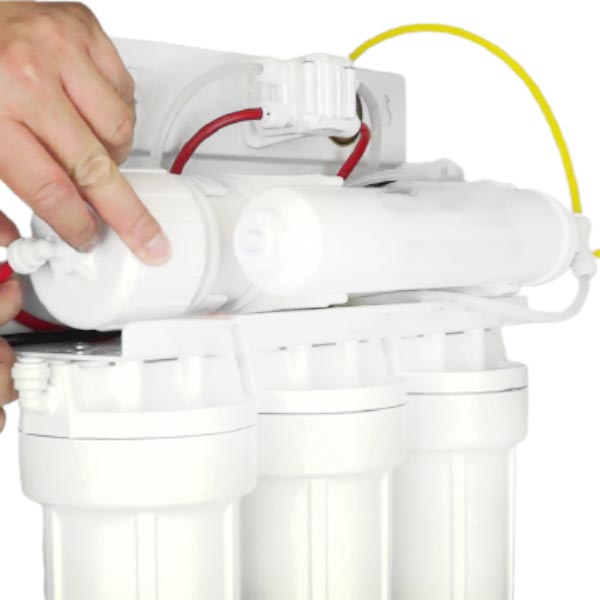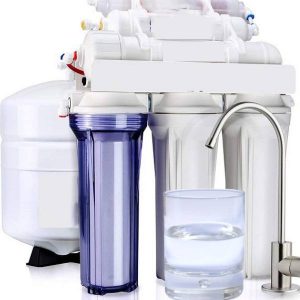Does Reverse Osmosis Remove Chlorine?
The short answer to this question is Yes, the reverse osmosis systems remove chlorine. The reverse osmosis membranes get rid of chlorine compounds present in our water supply.
Water molecules pass through the tiny pores of the carbon filter and RO membrane. This results in the eradication of all heavy metals, total dissolved solids (TDS), chlorine, and other chemicals.
They eliminate around 80-90% chlorine from your water supplies, making it safe to drink.
You might be wondering why chlorine is used in our water despite being harmful to our health. The answer is that it is the most pocket-friendly water treatment system.
Now, the main concern should be that how much Chlorine is safe and health-friendly to consume? According to the center for disease control and prevention(CDC), 4 milligrams of Chlorine per liter is safe to drink.
Any amount greater than this can put us at various health risks. The RO water filter is the most cost-effective solution to this problem. This filtration method passes water through the RO membrane to get pure water. Thus, removing contaminants like chlorine improves water quality and protects you from multiple health risks.
Impact Of Chlorine On Our Body
Chlorine is harmless to humans in quantities seen in the water supply. Many countries add chlorine or chloramine to their drinking water. They add chloramine to treat harmful microorganisms like bacteria and viruses that might make us sick if we consume them.
Swimming pool systems use chlorine or chloramine to sterilize their water because of its disinfection capacity.
Drinking chlorinated water will not harm you right away. But it may have a long-term health impact; some of them are as follow:
Asthma Symptoms
Chlorine is present in higher quantities in swimming pools. So if you go swimming often and inhale chlorinated water, it will affect your trachea and show mild asthma symptoms over time.
Food Allergies
Chlorine consumption in higher quantities can cause food allergies to a certain group of people with high dichlorophenol levels in their bodies.
Irritating Taste And Smell
Even though the amounts of chlorine in your drinking water are acceptable, the chlorine might leave an unpleasant taste or odor. If your water tasted or smells terrible, you’ll be less likely to drink it, and consuming too little water might result in dehydration.
When your water tastes bad, you and your household are more tempted to drink less healthy drinks like sodas or buy bottled water, which has its own set of problems.
Moreover, sometimes chlorine molecules in water produce certain contaminants like trihalomethanes, haloacetic acids, etc., through chemical reactions. These volatile organic compounds put us at various health risks. Hence, removing chlorine and other chemicals is really important for our health.
How Does Reverse Osmosis Work?
By passing water molecules through many layers of purification, reverse osmosis filtration systems eliminate chlorine. An RO system uses the following impurity removal methods:
- Pre-filter for sediment removal
- Reverse Osmosis Membrane
- Activated carbon filters
The overall reverse osmosis process is much more comprehensive. First, the activated carbon filter step removes the large bulk of chlorine. Then, the water passes through a semi-permeable membrane. The chlorine molecules are too big to pass across these tiny holes.
Following the filtering process, chlorine and any remaining pollutants are flushed down the drain with waste. The RO membranes allow only clean water, i.e., reverse osmosis water, to flow from your tap.
Which Other Pollutants Does Reverse Osmosis Process Remove
The reverse osmosis system is not just for removing Chlorine. It also eliminates some other harmful organic pollutants from the water and makes it safe to drink. Some of the pollutants are:
- Nitrates
- Pesticides
- Sulfates
- Fluorides
- Bacterias
- Pharmaceuticals
- Arsenic
Water flows from the rivers or other sources into the filter plants and then into our taps through pipelines. It is a long journey, and the water keeps collecting dust particles and other harmful elements during its flow.
RO systems remove chloramine and 99% of harmful organic pollutants.
Do All Reverse Osmosis Filters Remove Chlorine?
Not all, but a majority of them do remove chlorine. The removal of chlorine through an RO membrane depends upon:
- The thickness of the membrane
- Size of holes
- Settings of filter
- Amount of water flow
- Efficiency of filter
- carbon filters
Some low-quality chlorine water filters choke due to pollutants and pass water through them without filtration. So, make sure you buy the best reverse osmosis water system so that you won’t have to face such problems.
Problems With Reverse Osmosis Units
Sometimes, even a Reverse osmosis unit can give you a tough time. Some of the problems which reverse osmosis systems create are as follow:
Clogging
An RO system’s tiny holes can choke; thus, it must be serviced regularly. An RO system can be harmed by even ordinary chlorine. The only way to deal with this problem is to purchase an RO machine featuring a pre-filter to prevent it from clogging.
Replacement Of Filter
After you’ve bought and fitted the system, you’ll be able to refine water for cents per gallon. However, the extra cost of periodic filter replacements and cleaning is skyrocketing. Even though RO systems are almost maintenance-free, they must be cleaned and sterilized yearly.
Slow Process
Reverse osmosis requires a while since it uses home water pressure to force tap water across a semi-permeable membrane. You must give time for the RO process to restore the storage tank if you require a large amount of purified water at once and drain the system’s storage tank.

Other Water Filters That Remove Chlorine
Some other chlorine water filter systems which are best known to remove chlorine are:
Mechanical Filters
Mechanical filtration’s core concept is to use a wall to forcibly remove sand, debris, or any other particles from water. Mechanical filters can range from a simple net that takes out big trash to a ceramic one with an incredibly sophisticated pore structure that allows harmful germs to be filtered ultra-finely.
Absorption Filters
Carbon, which is very effective at collecting water-borne pollutants, is most often used in water filters for absorption. Carbon has a large central area that may trap chemical elements like chlorine, which is why it collects pollutants so quickly.
Sequestration Filters
The act of physically separating material is known as sequestration. Scale-inhibiting filters usually utilize food-grade polyphosphate to trap the calcium and magnesium ions that produce chlorine and corrosion.
Polyphosphate, on the other hand, is usually only used in trace levels, and it only slows scaling rather than eliminating it. This suggests that rather than softening the water, polyphosphate helps to maintain the minerals in the water.
Ion Exchange Filters
Ion exchange softens hard water by swapping magnesium and Ca ions with other ions like salt or hydrogen ions.
Electron transfer, unlike scale inhibition, actually eliminates hard ions, decreasing hydroxide ions and keeping water safe for uses where it is maintained at a continuous high temp, such as in industrial coffee makers.
Conclusion
We have thoroughly answered your question “Does reverse osmosis remove Chlorine” and mentioned every detail and info you should know about the
Are you weary of the harmful side effects of chlorine? A perfect solution is to buy a reverse osmosis water system to treat water at your home. They can improve the water quality tremendously.
You can install an under-the-sink RO membrane system and enjoy an unlimited supply of healthy water at pocket-friendly rates. Or you can go for an affordable water pitcher. They work wonderfully as well.
